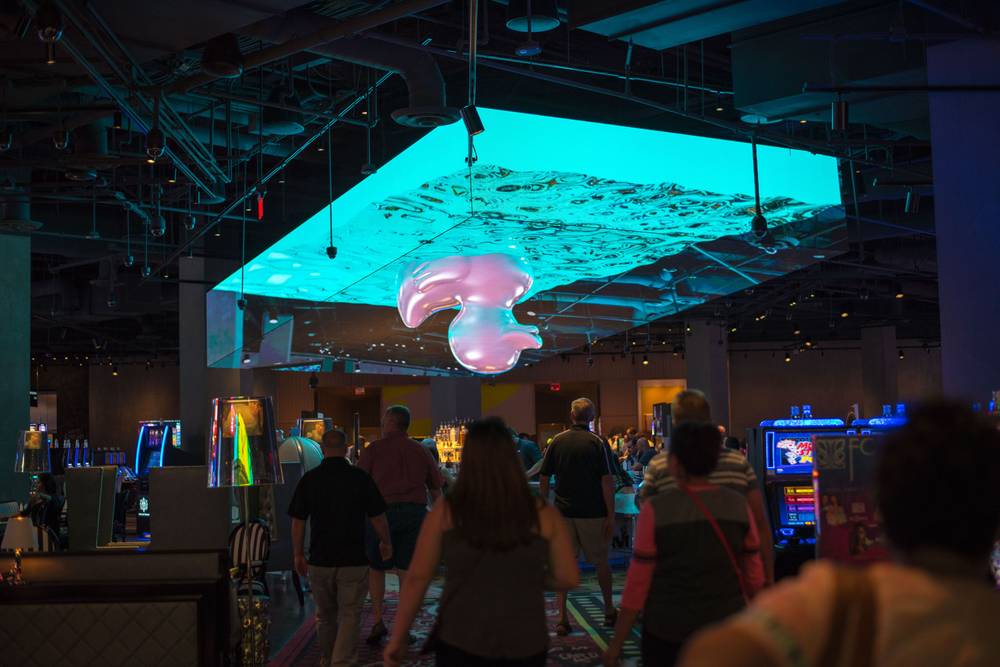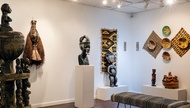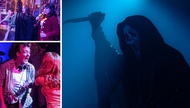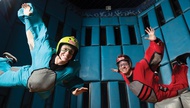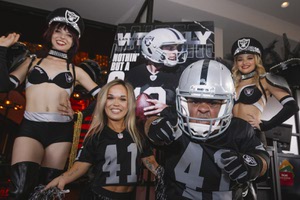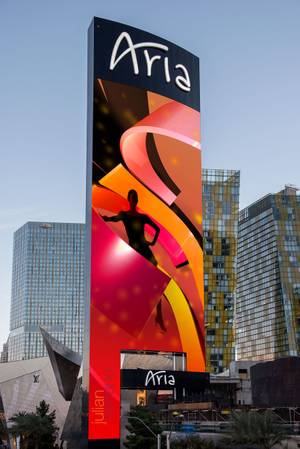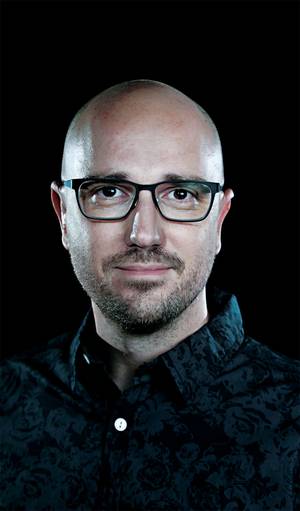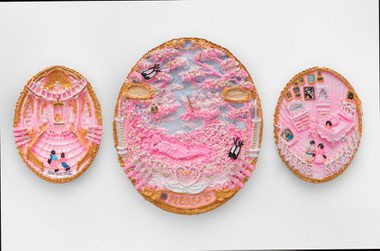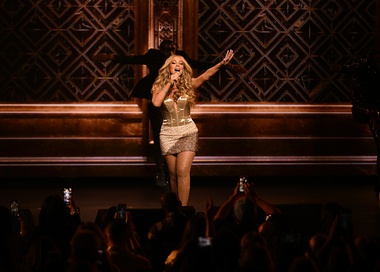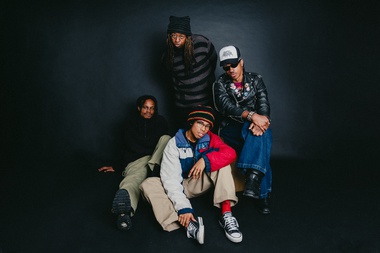Tourists stand near the main entrance of SLS fixated and jaw-dropped, watching a digitally animated duck float on the giant LED cloud above the Center Bar. Appearing three-dimensional, the illusion creates a rare moment when gawkers are too spellbound to pull out their camera-phones.
Brian Henry smiles.
This is his doing. The anamorphic duck designed for the 32-by-18-by-4-foot multisided LED screen follows his earlier design for it—a woman’s legs seductively swinging down from the projected molten liquid above, larger than life.
There’s no doubt that this town blazes in digital, but even with all the high-def conversation clamoring for attention on massive displays up and down the Strip, the Center Bar Cloud and its 2.1 million pixels, angled to provide a 3D mirage, take branding and digital entertainment to a new level.
“It’s fun to pursue something that’s cool and supports the brand but doesn’t have a direct marketing approach,” Henry says. “Something that’s beautiful and smart, but doesn’t have to slap you over the head.”
In New York City’s Times Square, LED screens several stories high—including one that covers an entire city block—combine color, movement and engineering with the sophisticated design that defines competitive digital advertising. Companies throughout the world are developing supersigns, proclaiming “the largest” or “highest resolution” vehicles for visual content that’s stirring and sharp. The pylons and marquees of Las Vegas play a similar role, most serving as brands for properties as they battle the next sign (and next sign) for eyeballs. At SLS, 3D projection mapping on two building exteriors presents abstract colors rhythmically pulsating or futuristic figures playing with energy fields.
“Technology has been a cornerstone of the guest experience at SLS Las Vegas since its initial conception, from the groundbreaking 3D mapping at Foxtail Pool to the digital Starck Frames and main registration desk,” says SLS vice president of marketing Jared Rapier. “These installations complement SLS’ whimsical design and turn the resort into an ever-evolving work of art. The Center Bar is no different, and the international attention it has received demonstrates how the classic Las Vegas attraction has been adopted for the next generation of tech-savvy destinations.”
So Henry is in the right place at the right time. His understanding of the nuances of design developed over a career that began right out of high school, when the native Las Vegan took a job at Anchor Gaming photographing facades of iconic hotels and sketching them—images that would eventually be stamped onto commemorative Silver Strike gaming tokens.
At 38, his imprint is all over the Boulevard: the more than 300-foot full-motion LED sign at the Harmon Corner that he co-designed with Young Electric Sign Company (YESCO), the 260-foot vertically oriented Aria marquee, the Linq’s digital sign and lighting schemes on its hotel’s Vortex Roof Deck. Henry even programmed the synchronized luminescence of the Swarovski crystal starburst at the Grand Bazaar Shops in front of Bally’s. The 14-foot sculpture, jutting from the top of the Swarovski boutique, has more than 1,800 choreographed points of light.
This is from someone who believed he’d need to move to LA to have a creative career in art and design, but learned he could carve a niche in Las Vegas’ evolution from neon and argon and static marquees to building-sized animated and lighting sequences. As a student at Las Vegas Academy in the 1990s, he had in his backyard a city legendary for its sculpted neon art framed by the dark, one that has transformed into a landscape of 24-hour high-definition video advertising—sophisticated and carefully programmed televisions overcoming the night sky.
“Digital signage is the medium of the contemporary Las Vegas skyline,” says Danielle Kelly, executive director of the Neon Museum. “The sheer volume of information that can be communicated through digital is breathtaking and malleable. Not only is the content relayed on a sign key to articulating the personality of a property, but how that information is conveyed visually articulates the personality and flavor of the place.”
She adds that Henry “has had a hand in many of the freshest, most creative and most on-point environmental lighting designs in Las Vegas.”
*****
As a child growing up here, Henry knew Fremont Street when cars drove up and down the gash of neon that yawned up into the sky. Now that stretch is covered with one of the largest LED video screens in world, literally blending past and present signage and mirroring the evolution of Las Vegas, a narrative that includes designers like Henry.
“My main drive was wanting to do something creative and artistic,” he says. “I could draw something that looked like a photo if I wanted to, but where’s the next step?
After his stint at Anchor Gaming, Henry spent 15 years with the esteemed YESCO. He worked in its interior sign division, first screen-printing belly glass on gaming machines and then designing animated sequences, leading him to work on some of the biggest projects at noted megaresorts. In 2013, he went independent with Brian Henry Design. Now he collaborates with YESCO while tackling solo projects, always tapping into the next thing.
That sentiment mirrors his approach to his personal artwork. He has created digital pieces for exhibits at the Life Is Beautiful Festival (where he whited out man-made elements in video footage of Nevada natural landscapes) and Trifecta Gallery. His Machina ex Machina at Trifecta in 2012 involved a computer program in which the machine went through a daily routine of waking itself up, creating an image every 30 seconds and saving it, resulting in thousands of computer-generated abstract works that could be ordered as one-of-a-kinds for print. Trifecta Gallery owner Marty Walsh later said that Henry’s show of parametric works was one of her favorites during her 11 years of operation, that for her it had one of the biggest impacts.
Henry and his wife, fashion designer Jennifer Henry (they met as teenagers working at Anchor Gaming), also had a studio and gallery in the Arts Factory for three years where they collaborated on art projects.
More recently, he’s collaborated with internationally recognized American artist Peter Wegner, whose work is in the permanent collections of major museums on both coasts.
Henry says his concentration on art projects is entirely separate from his commercial work.
“I don’t want to compromise my personal explorations,” he says. “That comes from absolutely compromising on the other side.”
His career is such that if he’s on the Strip chatting with someone and they ask, “So, what do you do?” the answer is easy.
